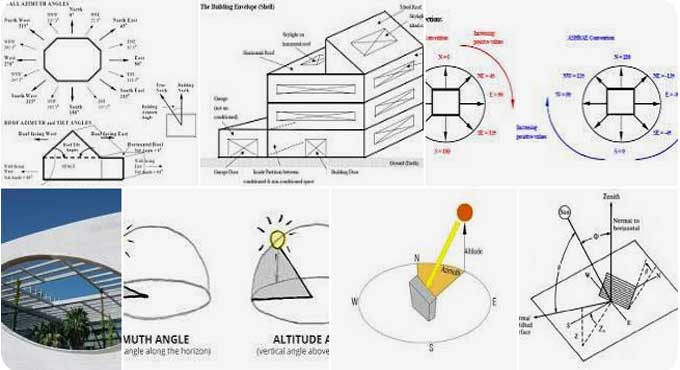
Building Design: The Importance of Azimuth Angle

The building design is just as much about a structure's orientation as its location.
When determining a structure's exposure to sunlight, the azimuth angle, the angle between true north and a line connecting its center to the sun, plays a significant role. Other factors, such as wind direction and ventilation potential, are also affected by azimuth angle, besides solar gain.
When designing a building, architects and engineers must take the azimuth angle into account.
What is the importance of the Azimuth Angle?
It can be defined as the angle between a line drawn from a particular location to the Sun and a line drawn from a particular location to the true north.
In order to maximize the efficiency of solar panels, it is important to understand what angle the sun will be at throughout the day as it moves across the sky. Therefore, you can orient them appropriately during the day and maximize their efficiency.
In addition to impacting how much sunlight an area receives each day, azimuth angle can also affect how much vitamin D people get over the course of the day.
Our measurement of the angular distance between the north point of the horizon and the intersection of the vertical circle passing through a celestial body is usually done clockwise.
An azimuth is a direction that can be found in the cardinal directions from which the object can be found. The angle varies between 0 degrees and 360 degrees, depending on the measurement.
How does azimuth angle relate to distance?
There is an angle between an object and the horizon that is known as the azimuth angle. It is most commonly used in the field of astronomy, but it can also be applied to a variety of other disciplines, such as architecture and design for buildings.
Azimuthal coordinates are usually used in astronomy to indicate the position of an observer or star in space (rather than in absolute terms), and angles from due north to eastward are measured using azimuthal angles.
When speaking about planets or stars that are close to either celestial pole, there is an exception to this general rule; in the case of these objects, the "overhead" position may correspond to any Azul combination where El is equal to 90 degrees minus latitude.
Because it impacts how much sunlight a structure gets, the azimuth angle is significant in architectural design.
There is more direct sunlight if a building's windows are oriented to the equator, than if they are oriented to the poles since the equator receives more direct sunlight than the poles.
This is especially true for regions where the amount of sunlight in the summer and the amount of sunlight in the winter differs significantly.
There is also an impact of azimuth angles on the calculation of solar heating and cooling loads. The windows of a building that are oriented towards the equator will receive more direct sunlight than those oriented toward the poles if they are oriented toward the equator.
If the difference between summer and winter sunlight levels is large, this can have a significant impact on the amount of energy in the environment. It is also important to consider azimuth angles when calculating solar heating and cooling loads.
To learn more, watch the following video tutorial.
Video Source: Reo Training
Surveying azimuth angles: what are they?
There are a number of definitions for azimuth angles, but the most general definition is that they are the angles between two points on the horizon, usually regarding celestial bodies. Property boundaries are determined by the azimuth angle in surveying.
Final thoughts
When designing a building, the azimuth angle is crucial. Your structure should be optimized for its location based on the position of the Sun and other environmental factors. In order to create a space that is much more comfortable and efficient, you will need to make good use of the azimuth angle through proper planning.


